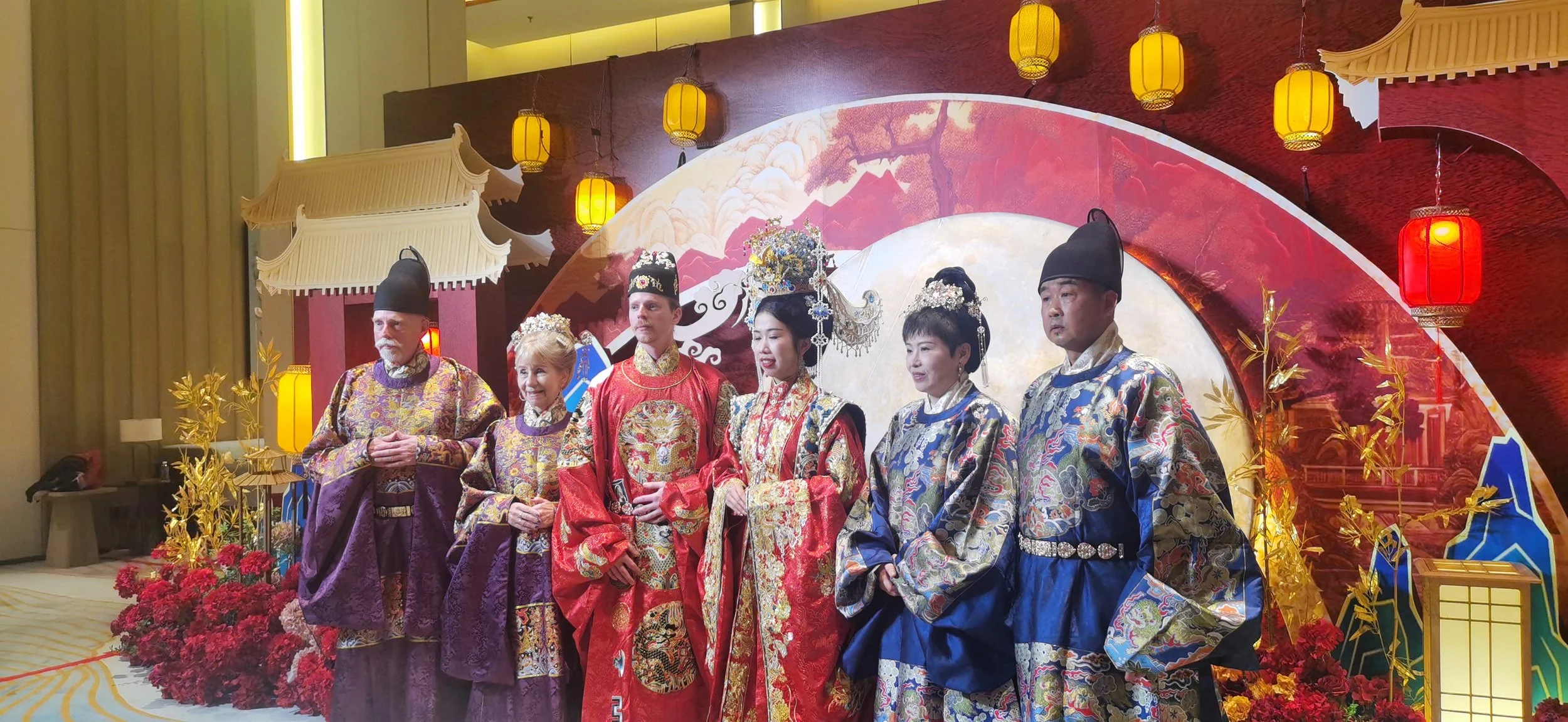
East Meets West: The Internationalization Trend of Chinese Weddings
25 October
By You Bangjian
Editor: Wan Chengyi
Photo of the newlyweds and their parents (Photo by Wedding Photographer)
Accompanied by traditional Chinese ritual music and a lively atmosphere, a “special” Chinese wedding focusing on two families from different nationalities was successfully held at the Narada Hotel, Fuzhou, and concluded perfectly on October 25.
For the newlyweds, Tom Barker and Xiao Yuanmin, this wedding not only witnessed their commitment but also symbolized the continuation of their family and culture. For the guests, this unique wedding, both in its form and content, was undoubtedly a delightful surprise.
While the "Ming-Style Han Wedding" format is one of the most popular Chinese wedding styles today, it wasn't the only unique aspect of this wedding. Perhaps even more noteworthy was the use of three languages throughout the whole ceremony. However, this seemingly novel hosting style has already seen numerous precedents in mainland China in recent years.
An Innovative Traditional Chinese Ceremony
Even there are already many precedents for multilingual wedding emcees, it is certain that this model is not common in mainland of China, especially for traditional Chinese wedding celebrations.
Mandarin, English, and the local Fuzhou dialect were all used in every step of the wedding. According to Xiao Yang, the wedding emcee, this language pattern was not only at the request of the couple, but more importantly, it was used to visualize the intricate and complex Chinese wedding process, thus avoiding cognitive biases from people with different cultural backgrounds.
As his first multilingual wedding officiated, Xiao Yang took this wedding very seriously. As what he shared, the overall preparation time for the wedding lasted three months, and two rehearsals were held with the newlyweds and their parents a week before the official start of the ceremony. It's clear that preparing a wedding of this type is not an easy task for wedding emcees in China today. However, the difficulty in preparing such a ceremony often doesn't stem from the emcee's own shortcomings, but rather fromwhether two families from different cultural backgrounds can accept, understand, and cooperate with each other.
One of the Wedding Procedures (Photo by Wedding Photographer)
Trends of Aesthetic Change With Each Generations
China's wedding market is not static. On the contrary, Chinese people's preferences for wedding styles and content change rapidly with the times and social environment.
According to "2021 China Wedding Industry Development Trend Research Report" from iiMedia, in 2021, 41.5% of newlyweds in China chose traditional Report" from iiMedia, in 2021, 41.5% of newlyweds in China chose traditional Chinese weddings, 33.8% preferred the then-popular "New Chinese Wedding" that combines Chinese and Western cultures, while other wedding styles,including traditional Western weddings, accounted for less than 15%.
2021 Consumer Survey of China’s Wedding Industry (Resource: iiMedia.cn)
Although the popularity of Chinese-style weddings exceeded 40% in 2021, Western-style weddings dominated the Chinese wedding market before 2016.
Zhu Chunye, the executive director and general manager of “The Thinker MC” Culture Communication Company in Fuzhou, has been working in wedding industry for over twenty years.
According to Zhu, in 2015, Western-style weddings accounted for over 60% of the Chinese wedding market, while traditional Chinese weddings accounted for less than 25%. He shared that due to factors such as complex procedures, high prices, and the prevailing social atmosphere, Chinese-style weddings were generally not popular between 2000 and 2015, and were even largely unknown.
With the rise of the traditional Chinese culture trend, traditional Chinese weddings have gradually been accepted and loved again by the Chinese public. Since then, Chinese-style weddings have been widely promoted and have continued to innovate with the changing times.
Oversea Communication and Internationalization
Guo Chao, a Chinese wedding emcee and lecturer, was invited by the Malaysian Chinese community to conduct wedding emceeing activities in Kuala Lumpur this October. In recent years, the overseas market for Chinese weddings has been gradually expanding, with overseas Chinese weddings becoming increasingly common, highlighting the internationalization trend of Chinese weddings.
However, with the slowdown of China's economy and the rise of non-marriage,the number of newlyweds is gradually decreasing. According to data from People's Daily, the number of registered marriages nationwide in 2024 is expected to decrease by approximately 20.5% compared to 2023. The trend of newlywed population decline is obvious.
For China's wedding industry and Chinese weddings, challenges and opportunities coexist. While remaining grounded in the essence of traditional Chinese weddings, continued innovation and quality improvement may be thekey to the future of Chinese weddings.
Mengenai kami
Nadi Bangi adalah portal akhbar makmal Program Komunikasi Media, Fakulti Sains Sosial dan Kemanusiaan, Universiti Kebangsaan Malaysia (UKM). Sebarang pandangan atau kandungan yang disiarkan tidak mewakili UKM. Ditubuhkan dengan objektif untuk menjadi suara warga kampus, Nadi Bangi menyajikan laporan berita, rencana khas, serta pandangan kritis berkenaan isu semasa yang berlaku di dalam dan luar kampus.


